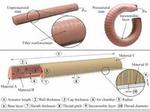Other

“Soft fluidic actuators consisting of elastomeric matrices with embedded flexible materials (e.g. cloth, paper, fiber, particles) are of particular interest to the robotics community because they are lightweight, affordable and easily customized to a given application. These actuators can …

“Autonomously flying microrobots with potential uses in crop pollination, search and rescue missions, surveillance, as well as high-resolution weather, climate and environmental monitoring Inspired by the biology of a bee, researchers at the Wyss Institute are developing RoboBees, manmade systems …

“‘Flat’ and ‘rigid’ are terms typically used to describe electronic devices. But the increasing demand for flexible, wearable electronics, sensors, antennas and biomedical devices has led a team at Harvard’s Wyss Institute for Biologically Inspired Engineering and John A …

“Since its discovery a decade ago, scientists and tech gurus have hailed graphene as the wonder material that could replace silicon in electronics, increase the efficiency of batteries, the durability and conductivity of touch screens and pave the way for …

“Materials science and mathematics combine to enable the printing of shapeshifting architectures that mimic the natural movements of plants. A team of scientists at the Wyss Institute for Biologically Inspired Engineering at Harvard University and the Harvard John A. Paulson …
“Metallophones such as glockenspiels produce sounds in response to contact. Building these instruments is a complicated process, limiting their shapes to well-understood designs such as bars. We automatically optimize the shape of arbitrary 2D and 3D objects through deformation and …

“For the last several years, Harvard has been developing a robot bee. They’ve done some impressive work: their sub-paper-clip-sized, 100-milligram flapping-wing micro aerial vehicle is fully controllable down to a stable autonomous hover. It’s still tethered for power …
